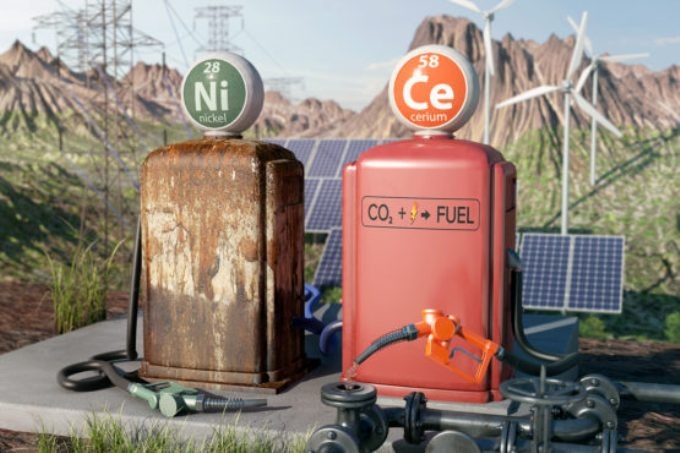Sep 18 2019
If the thought of flying on battery-powered commercial jets make people nervous, they can now relax a bit, thanks to a recent discovery.
 Artistic representation of a nickel-based electrode as a broken down fuel pump and of a cerium-based electrode as a new, productive pump. (Image credit: Cube3D)
Artistic representation of a nickel-based electrode as a broken down fuel pump and of a cerium-based electrode as a new, productive pump. (Image credit: Cube3D)
Scientists have identified a viable starting point for changing carbon dioxide (CO2) gas into sustainable liquid fuels. These also include fuels meant for heavier modes of transportation that can be very hard to electrify, say, freight trains, ships, and airplanes.
Reusing CO2 in a carbon-neutral way provides an alternative method to bury the greenhouse gas under the ground. In a new research recently reported in Nature Energy, scientists from the Technical University of Denmark (DTU) and Stanford University have demonstrated that CO2 can be converted into energy-rich carbon monoxide (CO) using an Earth-abundant catalyst as well as electricity. They also showed that this method is better than other traditional techniques.
Cerium oxide is a catalyst that does not break down easily. Removing oxygen from CO2 to produce CO gas is the first step to convert CO2 into virtually any liquid fuel and other products—for example, plastics and synthetic gas.
When hydrogen is added to CO, synthetic diesel fuels and the equivalent of jet fuel are produced. The researchers are hoping to use renewable power to produce CO gas and also for further conversions. This approach is expected to result in carbon-neutral products.
We showed we can use electricity to reduce CO2 into CO with 100 percent selectivity and without producing the undesired byproduct of solid carbon.
William Chueh, Associate Professor, Materials Science and Engineering, Stanford University
Chueh is also one of the three senior authors of the paper.
Being aware of DTU’s study in this field, Chueh invited Christopher Graves, associate professor in DTU’s Energy Conversion & Storage Department, and also Theis Skafte, who was a DTU doctoral candidate at the time, to come to Stanford University and develop the technology together.
We had been working on high-temperature CO2 electrolysis for years, but the collaboration with Stanford was the key to this breakthrough. We achieved something we couldn’t have separately—both fundamental understanding and practical demonstration of a more robust material.
Theis Skafte, Study Lead Author and Postdoctoral Researcher, DTU
Barriers to Conversion
Sustainable liquid fuels could have an advantage over the electrification of transportation—they can utilize the current diesel and gasoline infrastructure, such as gas stations, pipelines, and engines. Moreover, the barriers to electrifying ships and airplanes—such as the high weight of batteries and long-distance travel—would not pose a challenge to energy-dense, carbon-neutral fuels.
Although plants are capable of reducing CO2 to carbon-rich sugars in a natural way, an artificial electrochemical route to produce CO gas has not been extensively commercialized yet. Among the challenges: Devices utilize excess electricity, generate pure carbon that damages the device, or change a low percentage of CO2 molecules.
Scientists involved in the latest study initially investigated how different types of devices failed and succeeded in CO2 electrolysis. Based on this understanding, the team constructed a pair of cells for CO2 conversion testing—one with traditional nickel-based catalysts and the other with cerium oxide. Although the ceria electrode continued to be stable, carbon deposits destroyed the nickel electrode, considerably reducing the lifetime of the catalyst.
“This remarkable capability of ceria has major implications for the practical lifetime of CO2 electrolyzer devices,” stated DTU’s Graves, a visiting scholar at Stanford at the time and a senior author of the study. “Replacing the current nickel electrode with our new ceria electrode in the next generation electrolyzer would improve device lifetime.”
Road to Commercialization
The cost of commercial CO production can be dramatically reduced by eliminating early cell death. In addition, when carbon buildup is suppressed, the new device is able to convert more amount of the CO2 to CO, which is generally restricted to well below the 50% CO product concentration in existing cells. This means production can also be reduced.
The carbon-suppression mechanism on ceria is based on trapping the carbon in stable oxidized form. We were able to explain this behavior with computational models of CO2 reduction at elevated temperature, which was then confirmed with X-ray photoelectron spectroscopy of the cell in operation.
Michal Bajdich, Study Senior Author and Associate Staff Scientist, SUNCAT Center for Interface Science and Catalysis
The center is a partnership between Stanford’s School of Engineering and the SLAC National Accelerator Laboratory.
It is very costly to capture CO2 and this posed a problem to sequester this gas underground on a commercial level. The high cost involved can prevent the use of CO2 for making more sustainable chemicals and fuels. But the market value of these products along with payments for preventing carbon emissions can help technologies that utilize CO2 to resolve the cost barrier more rapidly.
The scientists believe that their preliminary work on exposing the mechanisms in CO2 electrolysis devices through modeling and spectroscopy will help other researchers to tune the surface characteristics of ceria and other oxides. This approach may further enhance the electrolysis of CO2.
Chueh is also a senior fellow at Stanford University’s Precourt Institute for Energy. Other co-authors from Stanford University are PhD alumnus Zixuan Guan, postdoc Michael Machala, former postdocs Matteo Monti and Chirranjeevi B. Gopal, and SLAC postdoc Jose A. Garrido Torres.
Other DTU co-authors are PhD candidate Lev Martinez, nanolab group leader Eugen Stamate, and staff researcher Simone Sanna. The other co-authors are Ethan J. Crumlin, a research scientist at Lawrence Berkeley National Laboratory, and Max Garcia Melchor, an assistant professor at Trinity College, Dublin.
The study was supported by Haldor Topsoe A/S, Innovation Fund Denmark, the Danish Agency for Science, Technology & Innovation and Energinet.dk., the U.S. Department of Energy, the SUNCAT Center, and a National Science Foundation CAREER award.